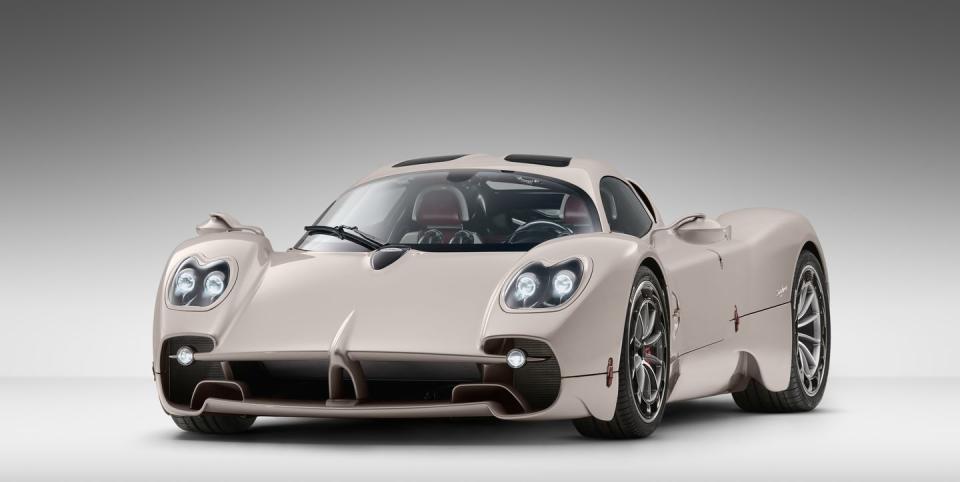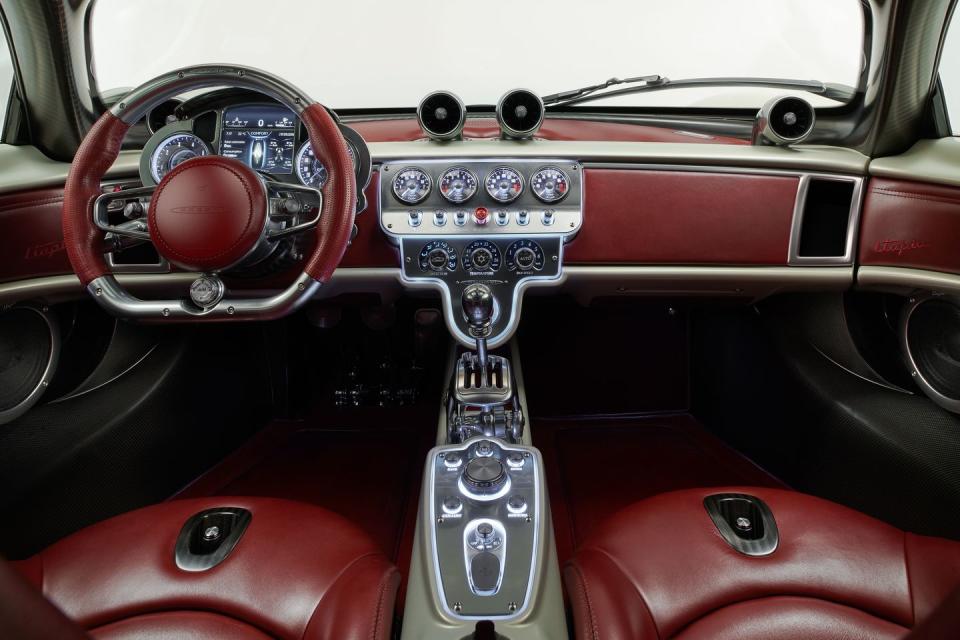2023 Pagani Utopia Is an 852-HP V-12–Powered Work of Art

Here's the first look at a spectacular new hypercar, Pagani's replacement for the Huayra.
The new car sticks with the twin-turbo AMG V-12 engine, which makes 852 horsepower.
It will be offered with a manual gearbox—which we hope all 99 buyers select.
Pagani is the modern supercar maker that blurs the line between automobile and art more than any other. That remains true with the Italian company’s new model, the Utopia, which you are seeing here for the first time. This is a car that would look as natural sitting on a plinth as in a garage.
While many of the design themes are familiar from the previous Huayra, Pagani promises that the Utopia's structure is entirely new. It was built around three targets set by company founder Horacio Pagani himself: simplicity, lightness, and the pleasure of driving.
The first of these qualities is why the Utopia isn’t following the rush of other hypercar makers to offer a hybridized powertrain. Instead, this car will continue to be powered as the Huayra was, by an AMG-developed twin-turbocharged 6.0-liter V-12 that produces peaks of 852 horsepower and 811 pound-feet of torque and sends all this fury to the rear wheels.

"Carbo-Titanium" Structure
Lightness is assured by the relative simplicity of the powertrain but also by a core structure that doesn't use mere carbon fiber; instead, it's made with Carbo-Titanium, which, as it sounds, is a mixture of composite and high-strength metal patented by Pagani. The combination of a Carbo-Titanium center structure, lightweight carbon bodywork, and chrome alloy subframes means the Utopia is claimed to have a dry weight of just 2822 pounds.
The third quality of drivability brings a gloriously unlikely feature back into play: This is—as Horacio has hinted in previous interviews with Car and Driver—a hypercar with the option of a manual gearbox. Admittedly, it isn't alone in offering a stick shift. Gordon Murray's GMA T.50 gets one as standard, and the Koenigsegg CC850 has a shift-by-wire manual. Pagani will also offer an automated single-clutch transmission for those who don’t want to save their left legs from exercise, or more likely to avoid the need to learn to drive stick in the first place. Pagani discounted the idea of following the herd and just offering a dual-clutch transmission on the grounds of weight and complexity.
Aerodynamically Elegant
We don't have any claimed performance figures yet, although the compelling simplicity of its power-to-weight ratio means we can safely predict that the Utopia will be stupendously quick. Despite that, the Utopia looks set to quicken pulses as much through its stunning design as its ability to create g-forces. Pagani says the shape is the result of thousands of hours of wind tunnel testing. The hard-working surfaces cut drag and add downforce without the need for anything as vulgar as a racer's elevated wing pushed into the airflow. As in the Huayra, there are two active elements operating in channels; they're divided by the brand's trademark quadruple exhaust, but also part of an oval element when viewed from the back.
Other spectacular details include the continued use of leather straps to secure the front and rear clamshells in place, with the rear opening revealing luggage panniers as well as the car's rear structure. The Utopia sticks with butterfly opening doors and sits on alloy wheels—21 inches at the front and 22 at the back—with turbine shaped vanes to channel hot air away from the brakes. Look closely and you’ll see these are in the shape of a plan view silhouette of the car itself. The roof incorporates two windows, and a small rear screen reminiscent of the early Lamborghini ‘periscopio’ for rear vision. Behind and beneath this is a glazed engine cover, this offering both a view of the top of the V-12 but also—through another small window—a view of the four dials in the center of the dashboard.

Classy Analog Interior
The exterior is special, but the interior is definitely special-er. Horacio Pagani has previously complained about the trend for the large display screens that dominate most high-end automotive interiors. Utopia buyers will be spared the need to deal with one of those. There is a single screen between the mechanical speedometer and rev counter, but everything else is entirely analog. The cabin is built and finished to a standard that makes other hypercars seem shoddy. The steering wheel is milled from a single aluminum block, as are the individual pedals, and the exposed shifter for the seven-speed manual transmission is a design masterpiece in its own right. It would be a crime to choose the robo-box and order this car without it.
While the Pagani Zonda was named after a wind and the Pagani Huayra after a wind god, the Utopia’s title has its origins in medieval intellectual thought. "For the philosopher Thomas More in 1516, Utopia was a place that did not exist," the official press release intones, "and ever since then the name has been given to the idealized places of which we dream." Something that seems entirely justified by the finished reality.
Just 99 Utopia coupes will be produced, with these set to be built at a rate of just one a week at Pagani's factory in San Cesario sul Panaro in Modena, Italy, with the first deliveries starting midway through next year for cars fitted with the automated manual gearbox. The manual will follow later. Pagani has also invested the time and money necessary to give the car full federal homologation in the United States—no need for any "show and display" fudges here. Marketing director Christopher Pagani confirms that the entire run has already been assigned to buyers, despite a price that's the equivalent of $2.5 million. By the increasingly surreal standards of limited-run hypercars, that almost makes it a bargain.
You Might Also Like

 Yahoo Autos
Yahoo Autos 